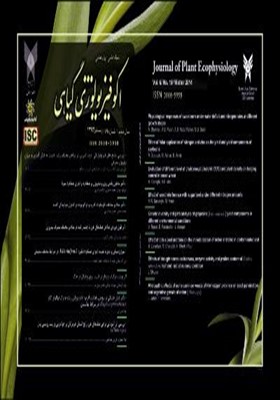بررسی اثر آللوپاتی برخی علفهای هرز رایج استان هرمزگان بر جوانهزنی و رشد رویشی پیاز (Allium cepa)
محورهای موضوعی : مجله علمی- پژوهشی اکوفیزیولوژی گیاهیلیلا جعفری 1 , فرزین عبداللهی 2
1 - عضو هیات علمی دانشگاه هرمزگان
2 - استادیار دانشگاه هرمزگان
کلید واژه: سرعت جوانهزنی, آللوکمیکال, پنجهکلاغی مصری, تاجخروس, میزان کلروفیل برگ,
چکیده مقاله :
به منظور بررسی تأثیر بازدارندگی عصارههای آبی و بقایای گیاهی اندامهای مختلف علفهای هرز تاجخروس، سلمهتره، خرفه، پنیرک و پنجهکلاغی مصری بر جوانهزنی و رشد گیاهچه پیاز مطالعات آزمایشگاهی و گلخانهای بهصورت فاکتوریل در قالب طرح کاملاً تصادفی در 3 تکرار در گروه باغبانی دانشگاه هرمزگان انجامشد. فاکتورهای مورد مطالعه در پژوهش آزمایشگاهی شامل 5 علف هرز ذکر شده، 6 غلظت عصاره (0، 1، 2، 4، 8 و 10 میلیلیتر) 3 اندام برگ، ساقه و ریشه علف هرز و در پژوهش گلدانی شامل بقایای گیاهی پودر شده برگ، ساقه و ریشه علفهای هرز به میزان 0، 1، 2، 4، 8 و 16 گرم در گلدان بود. در نتایج آزمایشگاهی بیشترین خاصیت بازدارندگی در دو علفهرز تاجخروس وپنجهکلاغی مصری مشاهدهگردید. در اکثر صفات مورد مطالعه تفاوت معنیداری بین این دو علفهرز مشاهده نگردید ولی اثر بازدارندگی علف هرز تاج خروس بر صفات سرعت جوانهزنی، طول ریشهچه، وزن خشک ریشهچه و گیاهچه پیاز بیشتر از علف هرز پنجهکلاغی مصری بود. در اغلب موارد با افزایش غلظت عصاره اندامهای مختلف علفهرز، درصد جوانهزنی، سرعت جوانهزنی و ویژگیهای رویشی گیاهچه پیاز بطور معنیدار کاهش یافت. نتایج گلخانهای نشان داد که حضور بقایای علفهای هرز در خاک موجب کاهش رشد رویشی و میزان کلروفیل برگ گیاهچه پیاز گردید. دو علفهرز تاجخروس و پنجهکلاغی مصری بیشترین اثر بازدارندگی را بر تمام ویژگیهای رویشی گیاهچه پیاز در شرایط گلدانی داشتند. اما اثر آللوپاتی علفهرز تاجخروس بر درصد رویش گیاهچه و کلروفیل a بیشتر بود. نتایج این پژوهش نشان داد که دو علف هرز تاجخروس و پنجهکلاغی مصری در مقایسه با علفهای هرز خرفه، سلمهتره و پنیرک تأثیر بازدارندگی بیشتری بر رشد و جوانهزنی پیاز داشتند، لذا توصیه میگردد قبل از کاشت پیاز نسبت به پاکسازی این دو علفهرز در مزارع پیاز استان هرمزگان اقدام جدی صورت گیرد.
In order to investigation of allelopathic activity of aqueous extract and different plant tissues residues of Amaranthus retroflexus, Portulaca oleracea, Chenopodiunm album, Dactyloctenium aegyptyum and Malva neglecta on seed germination and seedling growth of onion, laboratory and pot experiments were performed as a factorial experiment basis of a completely randomized design with three replications in Horticultural science Department of Hormozgan University. In laboratory experiment, studied factors were included five weeds species, six concentrations (0, 1, 2, 4, 8 and 10 ml) of aqueous extract of different tissues (leaf, stem and root) of tested weeds and in pot study, experimental factors included five weeds species, six amounts (0, 1, 2, 4, 8 and 16 gram per pot) of ground residues of different tissues (leaf, stem and root) of studied weeds. Results of this study indicated that in laboratory experiment, A. retroflexus and D. aegyptyum had the most allelopathic effects on onion. Although in most of the studied traits no significant differences were observed between these two weeds, but inhibition effects of A. retroflexus was higher for germination rate, radicel length and dry weight and seedling dry weight. With increase in extract concentrations, almost of onion seedling growth characteristics decreased significantly. Results of pot experiment showed that the weed residues incorporated in soil inhibited the growth and leaf chlorophyll a content of onion. Both A. retroflexus and D. aegyptyum had the maximum inhibition effects on all of onion vegetative growth trails. But A. retroflexus allelopathic effects on seedling emergence percentage and chlorophyll a content were more obvious. Results of this study indicated that since between studied weed species, A. retroflexus and D. aegyptyum had the most allelopathic effects on onion seed germination and vegetative growth characteristics, therefore these two weeds must be controlled completely before onion cultivation.


